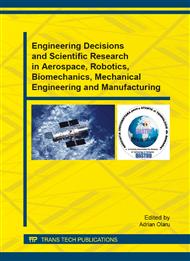[1]
R. D. Rugescu, Burning Laws of Solid Propellants by Multiple Splines, Scientific Bulletin of U.P.B., series B, Chemistry and Materials Science, 62, 1(2000), 41-50.
Google Scholar
[2]
F. Bartlma, Gasdynamic der Verbrenung, Springer Verlag, Wien and New-York, 1975, mainly at p.129.
Google Scholar
[3]
J. Ballmann, Introduction to Gasdynamics, Lehr-und Forschungs-gebiet fur Mechanik, RWTH Aachen, 1991, 10-1, 10-44.
Google Scholar
[4]
M. A. Eagar et al., Ignition Transient Modelling for the Space Shuttle Advanced Solid Rocket Motor, AIAA-SAE-ASME-ASEE 29-th, Joint Propulsion Conference, Monterey Ca, 28-30 June 1993, 12 p.
DOI: 10.2514/6.1993-2062
Google Scholar
[5]
W.A. Johnston, Solid Rocket Motor Internal Flow During Ignition, J. Prop. Power, 11, 3, May-June 1995, 489-496.
DOI: 10.2514/3.23869
Google Scholar
[6]
B.A. Pardue, Ignition Transient Analysis of a Solid Rocket Motor Using a One-dimensional Two-fluid Model, AIAA-SAE-ASME-ASEE 28-th, Joint Propulsion Conference, Nashville, TN, July 6-8, 1992, 8p.
DOI: 10.2514/6.1992-3277
Google Scholar
[7]
W.A. Jr. Foster et al. Development a New Generation Solid Rocket Motor Ignition Computer Code-Final Report, NASA-CR-195734, NAS 1. 26: 195734, Feb. 1994, 173p.
Google Scholar
[8]
R. Rugescu, Modelling of One- dimensional Unsteady Flows in Rocket Engines, Rev. Roum. Sci. Techn-Mec. Appl., 46, 1-6(2001), 77-109.
Google Scholar
[9]
Rugescu, R. D., The unit histogram concept for scarce statistical information, AECE Journal, Advances in Electrical and Computer Engineering-AECE Journal, ISSN 1582-7445, Vol. 9, No. 3, 2009, 68-74.
DOI: 10.4316/aece.2009.03013
Google Scholar
[10]
Daneshyar, One-dimensional Compressible Flow, Pergamom, 1976, 179p.
Google Scholar
[11]
Vigor Yang, Liquid rocket thrust chambers: aspects of modeling, analysis, and design, ISBN 1563472236, 9781563472237, AIAA Progress in astronautics and aeronautics, Vol. 200, 2004, 725 p.
DOI: 10.2514/4.866760
Google Scholar
[12]
F. Stratulat, and F. Ionescu, Linear Control Systems: Analysis and Synthesis, Theory and Applications, Englisch, ISBN-13 978-3938062722, Steinbeis-Edition, Auflage 1, 2009, 642 p.
Google Scholar
[13]
F. Stratulat (2008), Linear systems' stabilization by using dynamic compensation, U.P.B. Sci. Bull., Series C, ISSN 1454-234x, Vol. 70, Iss. 4, pp.37-48.
Google Scholar
[14]
F. Stratulat (2009), Comparative study of a mill machine's dynamics, U.P.B. Sci. Bull., Series C, ISSN 1454-234x, Vol. 71, Iss. 1, pp.45-60.
Google Scholar
[15]
Sassnik, H. D., and Krülle, G., Numerical simulation of transients in feed systems of cryogenic rocket engines, Proc. 31st AIAA Joint Conference and Exhibit, San Diego, CA, (1995).
DOI: 10.2514/6.1995-2967
Google Scholar
[16]
Ahuja, V., Simulations of Transient Phenomena in Liquid Rocket Feed Systems, (2000).
Google Scholar
[17]
Cavallo, P. A., Ashvin Hosangadi, and Vineet Ahuja, Transient simulation of valve motion in Cryogenic systems, (2005).
Google Scholar
[18]
Ahuja, V., Hosangadi, A. and Shipman, J., Multi-Element Unstructured Analyses of Complex Valve Systems, 52nd JPM/1st LPS Meeting, Las Vegas, NV, May 10-14, (2004).
Google Scholar
[19]
Shipman, J., Hosangadi, A., and Ahuja, V., Unsteady Analyses of Valve Systems in Rocket Engine Testing Environments, Paper No. AIAA-2004-3663, 40th AIAA/ASME/SAE/ASEE Joint Propulsion Conference and Exhibit, Fort Lauderdale, FL, July 11-14, (2004).
DOI: 10.2514/6.2004-3663
Google Scholar
[20]
Daines, R.L., Woods, J.L., and Sulyma, P.R., Computation Analysis of Cryogenic Flow Through a Control Valve, ', FEDSM2003-45120 4th ASME/JSME Joint Fluids Engineering Conference, Honolulu, Hawaii, July (2003).
Google Scholar
[21]
Manfletti, Chiara, Transient Simulation of Liquid Rocket Engines, a Step towards a More Educated Propellant Choice Between Kerosene and Methane, (2004).
Google Scholar
[22]
C. Manfletti, Transient behaviour modelling of liquid rocket engine components, DLR, (2009).
Google Scholar
[23]
Francesco Di Mateo, Modelling and simulation of liquid rocket engine transients, PhD Thesis, 2011, Universita Sapienta di Roma, page accessed on March 26, 2013, through the site http: /padis. uniroma1. it/bitstream/10805/1661/1/PhD_thesis_FDM. pdf.
Google Scholar
[24]
Yanzhong, Cui, Chen, and Yuanyuan. Pressure wave propagation characteristics in a two-phase Wow pipeline for liquid-propellant rocket. Aerospace, Science and Technology, 15: 453–464, September (2011).
DOI: 10.1016/j.ast.2010.09.011
Google Scholar
[25]
N. Yamanishi, T. Kimura, M. Takahashi, K. Okita, and H. Negishi, Transient Analysis of the LE-7A Rocket Engine Using the Rocket Engine Dynamic Simulator (REDS). In AIAA/ASME/SAE/ASEE 40th Joint Propulsion Conference and Exhibit, number AIAA 2004-3850, July (2004).
DOI: 10.2514/6.2004-3850
Google Scholar
[26]
G. B. Wallis, One-Dimensional Two Phase Flow, McGraw-Hill, (1969).
Google Scholar
[27]
J. P. Veres and T. M. Lavelle, Mean Line Pump Flow Model in Rocket Engine System Simulation, Technical Memorandum NASA-TM-2000-210574, NASA, November (2000).
Google Scholar
[28]
A. Bogoi, J-M Seyhaeve, R. D. Rugescu, O. Sugar, and M. Giot, Front wave prediction in water hammer phenomena involving two-phase flows, Paper 65838, ASME IMECE, November 15-21, 2013, San Diego, California, USA (accepted).
DOI: 10.1115/imece2013-65838
Google Scholar
[29]
C. Manfletti, Water Hammer Simulation Using a Lumped Parameter Model, in IAF, editor, Space Propulsion Conference, (2010).
Google Scholar
[30]
C. Manfletti, Start-Up Transient Simulation of a Pressure Fed LOX/LH2 Upper Stage Engine Using the Lumped Parameter-based MOLIERE Code, In 46th AIAA/ASME/SAE/ASEE Joint Propulsion Conference and Exhibit, number AIAA 2010-7046, (2010).
DOI: 10.2514/6.2010-6968
Google Scholar
[31]
C. Manfletti. Transient Behaviour Modelling of Liquid Rocket Engine Components, PhD thesis, Maschinenwesen der RWTH Aachen, (2009).
Google Scholar
[32]
T. Y. Lin and D. Baker, Analysis and Testing of Propellant Feed System Priming Process, Journal of Propulsion and Power, 11(3), May - June 1995, p.505 – 512.
DOI: 10.2514/3.23871
Google Scholar
[33]
B. Legrand, G. Albano, and P. Vuillermoz, Start up transient modelling of pressurized tank engine, AESTUS application, in the 4th International Conference on Launcher Technology, Space Launcher Liquid Propulsion, (2002).
Google Scholar
[34]
M. I. Shevelyuk, 1960, Teoreticheskie Osnovy Proektirovaniia Zhidkostnykh raketnykh Dvigatelei, Publishing House Oborongiz, Moscow, 684 pages.
Google Scholar


